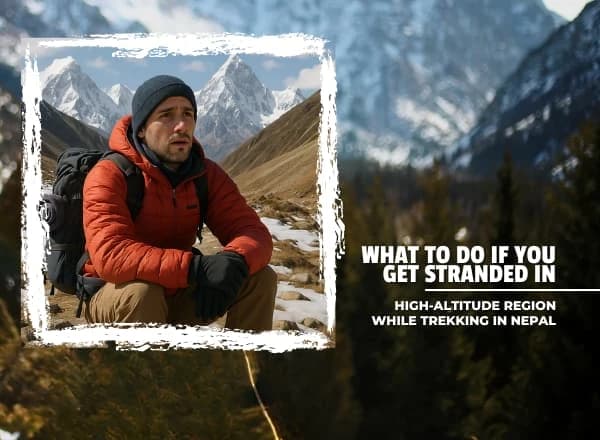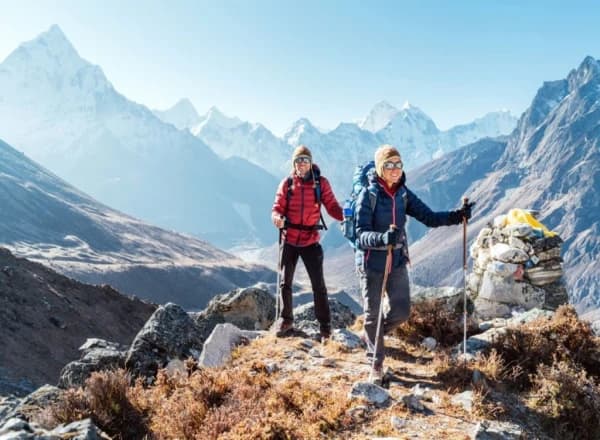Why Choose an Underrated Trek in the Everest Region?
First of all, let’s understand what is the need of choosing an underrated trek in the Everest region. Yes, the Everest Base Camp is an iconic trail with a combination of the views, cultural experiences, challenges, and more.
However, this route is often saturated during the main trekking seasons and the cultural experience is also slightly diluted as more and more locals have started entering the hospitality business. The local resources have become strained and the connection with nature seems to have been lost somewhere. The underrated trekking routes have not yet been touched by these issues. They give you the same awe-inspiring views combined with silence, solitude, serenity, and a chance to witness the true rhythm of Sherpa life without a hint of modernization.
Along with this, these trekking routes also offer authenticity, mindfulness, and personal transformation by allowing the trekkers to connect with themselves and with nature.
Underrated Trekking Routes in the Everest Region:
Now, let’s get into the main topic which is the underrated trekking routes in the Everest region. The region features several off-the-beaten-path treks, some of the most rewarding ones are listed below:
1) Everest Three Passes Trek:

The first one on the list has to be the Everest Three Passes Trek which is an ultimate high-altitude adventure which covers around 160 to 180 kilometers of distance within 17 to 20 days. This trek is considered a challenging one as it links the trail of the Everest Base Camp with three stunning high mountain passes of the Everest region, i.e. Kongma La (5,535m), Cho La (5,420m), and Renjo La (5,360m). The Everest Three Passes trek spans the entire geographical and cultural spectrum of the Khumbu region as it takes you through all the major valleys of the Everest region.
This is what adds more diversity to the trek as you will see everything ranging from glaciers and turquoise lakes to frozen passes and Sherpa villages connected by ancient trade routes. This route is often reserved for experienced trekkers who have excellent physical fitness and exposure to high altitude as you will be crossing three high altitude passes back-to-back. Kongma La, the highest and often most difficult, Cho La Pass (5,420m); a stunning, icy crossing linking the Khumbu and Gokyo valleys, and the Renjo La Pass (5,360m) with arguably the best panoramic view of Everest, Lhotse, Makalu, and Cho Oyu are the greatest highlights of the trek.
The only time you will briefly see crowd on the trail is when it crosses into the main EBC route. Besides that, this underrated trek will allow you to not just witness the mountains but to move through them, earning every single view.
2) Gokyo Lakes Trek:

Another hidden gem is the Gokyo Lakes Trek which is often hailed for having the most beautiful scenery in the Everest region. So much so that it is often cited as the best alternative to the EBC trek and its panoramas are considered superior to that of the EBC trek.
This route passes through the Gokyo valley and can be regarded as a tranquil blue paradise as it takes you through a collection of six major and 19 smaller lakes that sit between 4,700 m and 5,000 m, covering an area of 485 acres. The main lakes covered in the Gokyo Lakes Trek are the six freshwater lakes including Longpanga Tsho (1st Lake), Taujung Tsho (2nd Lake), Gokyo Tsho (3rd Lake), Thonak Tsho (4th Lake), Ngozumpa Tsho (5th Lake), and Gyazumpa Tsho (6th Lake).
Other highlights of the trek include Gokyo Ri (5,357 m) which is a viewpoint of the Everest region that gives a stunning panorama of Everest, Lhotse, Cho Oyu, and Makalu all in one frame. During the trek, you will be going alongside and across the Ngozumpa Glacier which is regarded as the longest glacier in the Nepalese Himalayas. Also, the lakes are considered sacred too which further adds a dimension of spirituality to the trek.
3) Pikey Peak Trek:

Located in the lower Everest region, the Pikey peak trek can be covered within 6 to 8 days and it is regarded as the best short trek in the Everest region which can be easily completed. Don’t think of it as any less than the other treks as the Pikey Peak Trek offers 360-degree Himalayan views that inspired even Sir Edmund Hillary, who claimed it gave him his favorite view of Mount Everest. The Pikey Peak gives an excellent panorama of Everest, Lhotse, Makalu, Kanchenjunga, and even Dhaulagiri can be seen shining in the distance. This is the best trek alternative for people who have limited time but want to experience the Everest region.
Also, even this trek doesn’t have so much crowd as the EBC trek, so it gives you a chance to silently connect with nature. The route is equally beautiful as you cross rhododendron forests, yak pastures, and Sherpa monasteries, including the sacred Chiwong Monastery.
4) Renjo La Pass Trek:
If you don’t have enough time to explore all the three passes of the Everest region, you can stick to exploring just one and the best option to explore is the Renjo La Pass. The pass stands at a staggering altitude of 5,360 meters and features some of the most iconic views of the Everest region. Doing just the Renjo La Pass too requires physical fitness, but not as much as the Everest Three Passes Trek. From the high altitude pass, you will get spectacular views of Mt. Everest, Lhotse, Makalu, and Cho Oyu while the turquoise Gokyo Lakes can be seen shimmering below. As you cross villages like Thame and Lungden, and the Thame monastery, you will see Himalayan life unfold with lots of traditional houses, ancient gompas, and Buddhist relics.
5) Ama Dablam Base Camp Trek:
A base camp adventure similar to the Everest Base Camp Trek is the Ama Dablam Base Camp trek. However, it is a quieter alternative which takes you to the foot of Mt. Ama Dablam. This peak is regarded as the most beautiful mountain in the Himalayas, and it gives you some of the most stunning panoramas of Lhotse, Nuptse, Taboche, Kangtega, and Thamserku surrounding you. The trek begins from Lukla as a journey similar to the EBC trek. The route changes from Pangboche after which you will be passing through vibrant Sherpa villages, suspension bridges draped with prayer flags, and dense rhododendron forests. Traversing across the Sagarmatha National Park, the Ama Dablam Base Camp Trek offers a quieter and more intimate trekking experience as compared to the Everest Base Camp Trek.This makes it a great option for trekkers who want to experience the grandeur of the Everest region, minus the crowd of EBC trek. It can also be done as an acclimatization trek for mountaineering enthusiasts.
6) Hinku Valley and Mera Peak Trek:
If you are seeking a completely unique experience in the Everest region, the Hinku valley and Mera Peak Trek is the best choice for you, especially if you are seeking an adrenaline rush. This route is regarded as a challenging one and it takes around 15 to 18 days to complete. In this route, you will be combining the thrill of trekking with the adrenaline rush of mountaineering. Mera Peak is the highest trekking peak in Nepal at an altitude of 6,476 meters. And this trail takes you through isolated valleys, dense rhododendron forests, and alpine meadows.
Even if you don’t climb the peak, just the journey on this trail is diverse as you go across alpine valleys, suspension bridges, and glacial moraines. And it is much more secluded and connected to nature as opposed to the EBC trek.
This route also requires you to be extremely fit as you not only have to summit the Mera Peak but you also have to corss high altitude mountain passes like the Zartwa La Pass at 4,610 meters.
Climbing the Mera Peak doesn’t require much technical knowledge, just enough determination. And you will enjoy the panoramic views of Everest, Lhotse, Makalu, Kangchenjunga, and Cho Oyu from the top.
7) Pangboche Phortse Loop:
While not a separate trek in itself, for people who want a couple of days of solitude within the Everest Base Camp trek, you can head towards the Pangboche Phortse loop. This side route of 1 to 2 days is considered the hidden Sherpa heritage route. It is one of the least traveled yet most scenic segments of Khumbu from where you can see frequent sightings of the national bird of Nepal, i.e; Himalayan monals. It also showcases the authentic Sherpa lifestyle, peaceful monasteries, and stunning views of Ama Dablam and Thamserku, leading to Phortse village. This can be a great detour during the EBC journey.

Practical Tips to Explore the Underrated Treks in Everest Region:
Exploring the underrated treks in the Everest region can be exhilarating, but it also requires much more preparation as these treks are not full of booming hospitality industry unlike the Everest Base Camp trek.
So, stick to these tips to have a safe and enjoyable trekking experience:
- Pack smartly and take all the essentials as you will not get any shops on these off-the-beaten-path treks. So, you have to come prepared since the beginning.
- Keep all your documents, permits, and cash safe as you might end up in problems if you lose track of these.
- Pick the trekking season wisely by weighing down the pros and cons of every trekking season in the Everest region.
- Hire a licensed trekking guide and porter, a local one who knows the area in and out, as the remote trekking routes have fewer facilities and less signage.
- Expect simpler teahouses and a much more limited menu as compared to the EBC trek as these treks are very remote.
- Choose a reliable and trusted local trekking agency like Beyond the Limits Treks and Expeditions for logical support and safety during the trek.
- Learn to recognize symptoms of Acute Mountain Sickness (AMS) and take measures to prevent altitude sickness, such as staying hydrated and avoiding alcohol.
Related Blogs:
Conclusion
The Everest region is a vast realm which expands far more than just the trail to the Everest Base Camp. The lesser known routes of the region hold the magic of discovery, silence, and authenticity. And this magic is displayed only to those who are willing to step off the established route. Choosing an underrated trek in the Everest region allows you to find a new perspective in the Himalayas.
If you want to go beyond the limits and trek beyond the crowds, contact us at Beyond the Limits Treks and Expeditions today to book your next trekking adventure in the Everest region.








